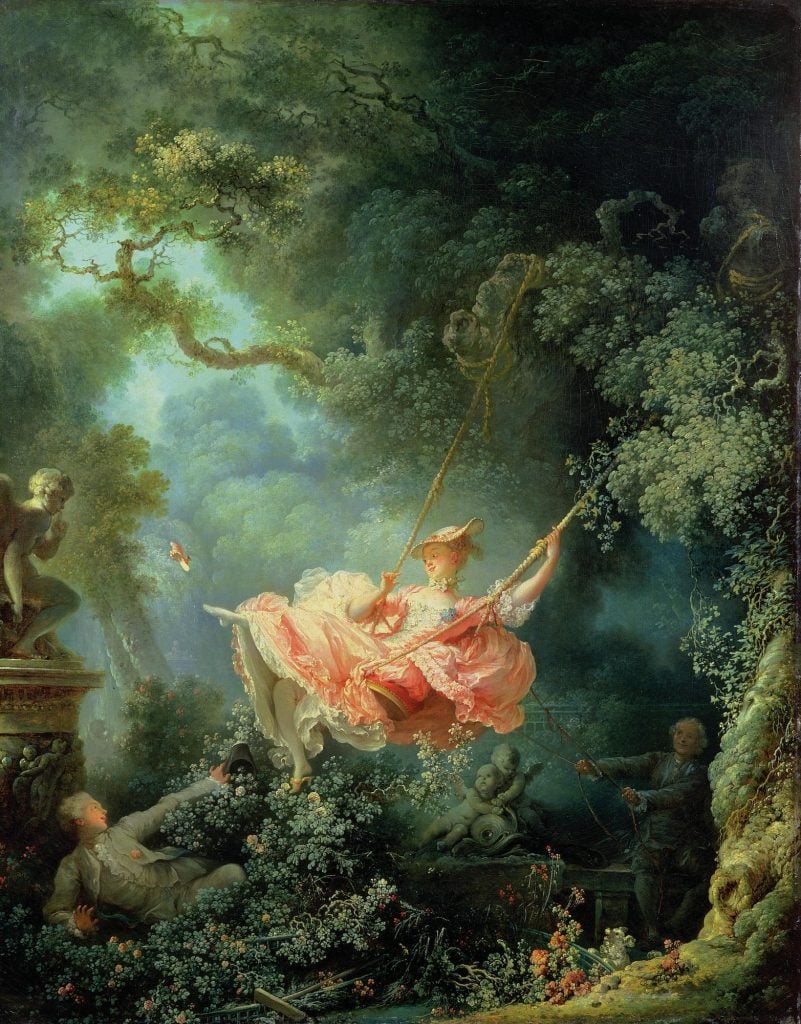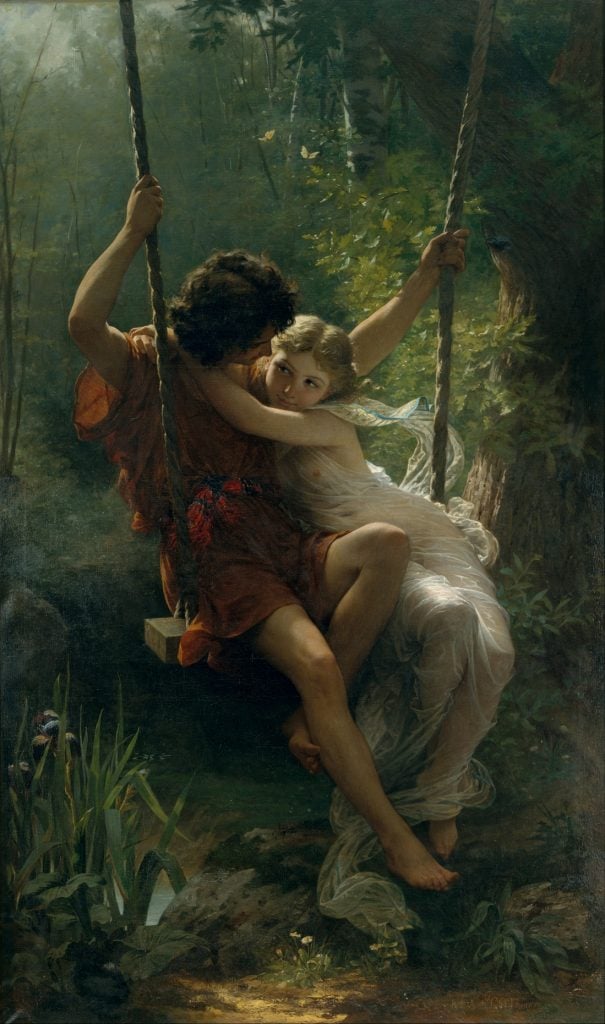A young maiden stares deeply into the eyes of her beloved, wrapping her arms languidly around his neck. In a lush green forest, these lovers sit side by side on a rope swing that hangs suspended from the unseen branches above. Butterflies flutter overhead. A small pool of water glitters below. The girl, beautiful and coquettish, wears a diaphanous and luminously white gown, reminiscent of an ancient Grecian peplos, which winkingly reveals her idealized figure. Meanwhile, the young man sports a historically inspired, rustic tunic with a red sash at his waist. He gazes down tenderly toward the woman’s face, and raises his leg as thought about to push the swing forward. Their bodies lean provocatively toward each other with palpable tension.
Pierre-Auguste Cot’s Springtime (1873) is an unapologetically romantic painting, and one that is immediately recognizable—even if the painting’s name and story may not be readily familiar. Cot, a student of French academic painter William-Adolphe Bouguereau, painted Springtime in 1873 and exhibited it at the Salon in Paris that year. There the painting was displayed with the accompanying lines, “O primavera! gioventù dell’anno! / O gioventù! primavera della vita!!!” (Oh spring! youth of the year! / Oh youth! spring of life!!!).
Springtime is both a celebration of the beauty of youth and an allegory of rebirth and splendor of the season. The image is unreal in its beauty; one can see that while the young woman’s dress is flowing from the movement of the swing, the couple themselves are still.
In the 150 years since its creation the rapturously sensual image has been popularized the world over, through prints, postcards, cups and all other manner of reproduction. An iconic painting of young romantic love, Springtime has a fascinating backstory, too. As the season of rebirth begins, we’ve taken a closer look at the image and located three fascinating facts that just might change the way you see it.
It’s Part of a Long Line of Flirtatious Swing Scenes

Jean-Honoré Fragonard, The Swing (ca. 1767). Courtesy of the Wallace Collection, London, United Kingdom.
While harkening back to the Arcadian idylls made famous by Nicolas Poussin, Springtime also references the flirtatious French genre of swing scenes, embodied most famously by Jean-Honoré Fragonard’s Rococo masterpiece The Swing (1767). Fragonard, in fact, painted not one but three unique depictions of women on swings. These scenes of frivolity allowed for a spirit of playful transgression, hinting at courtship and intimacy through seemingly innocent revelry. Fragonard’s frothy image depicted an aristocratic woman ensconced in a voluminously ruffled pink dress as she is pushed on a swing by a man—perhaps her unassuming husband—while her inamorato peeks scandalously upwards from below.
“With the exhilaration of vertigo play, swinging permitted occasions of sexual disorder where uninhibited positions revealed the body and spectators glimpsed views that were usually hidden from sight,” observed art historian Jennifer Milam in her essay “Playful Constructions and Fragonard’s Swinging Scenes.” Other examples of this popular genre include Nicolas Lancret’s The Swing (1730) and Francisco Goya’s interpretation from 1779. In Cot’s case, he adds one more layer of reassuring distance between his viewers and the potentially transgressive scene by placing his figures in an ancient past. “One marvels at the degrees of eroticism tolerated (or excused) in the name of classicism by a clientele who generally wanted nothing faintly overt of this sort,” wrote a later critic.
The Painting Has a Counterpart in The Storm

Pierre-Auguste Cot, The Storm (1880). Collection of the Metropolitan Museum of Art, New York.
With the Salon of 1873, Springtime became an immediate public sensation. John Wolfe, the painting’s first owner, took immense pleasure in hanging the work prominently in his Manhattan home, and his cousin Catharine Lorillard Wolfe was so besotted by the scene, she commissioned her own composition from Cot. This painting, The Storm, has come to be known as Springtime’s “spiritual pendant” and it depicts a young couple—perhaps even the enamored youths from Springtime—dashing through the woods, he in a state of half-dress and she in a similar gown as depicted in Springtime. The couple, arm-in-arm, hold a length of fabric (perhaps her dress or overskirts) over their heads as they run for cover from a storm. Historians have sometimes interpreted the figures in the storm as Chloe and Daphnis from the story by the ancient Greek writer Longus, which tells the story of a boy and a girl who were each abandoned by their own parents and birth and grew up in innocence together and fell in love as adolescents. We might then apply this reading to Springtime, and the season to a phase of life. Still others have interpreted the maiden as a personification of spring itself, the flowers below her and butterflies above her, extensions of her beauty. Years later, Lorillard Wolfe was the benefactor who gifted The Storm to the Metropolitan Museum of Art.
After Vanishing for Decades, Springtime Was Rediscovered in a Pennsylvania Hotel
![Pierre-Auguste Cot's Springtime (1873) [left] and Storm (1880) right, with Cot's teacher William-Adolphe Bouguereau's Nymphs and Satyr (1873) at center.](https://news.artnet.com/app/news-upload/2023/03/ep_827.jpg)
Pierre-Auguste Cot’s Springtime (1873) [left] and The Storm (1880) right, with Cot’s teacher William-Adolphe Bouguereau’s Nymphs and Satyr (1873) at center. Courtesy of the Metropolitan Museum of Art, New York.




![Pierre-Auguste Cot's Springtime (1873) [left] and Storm (1880) right, with Cot's teacher William-Adolphe Bouguereau's Nymphs and Satyr (1873) at center.](https://news.artnet.com/app/news-upload/2023/03/ep_827.jpg)







